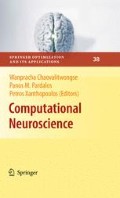Abstract
An estimated 42,000 epileptic patients die from status epilepticus (SE) every year in the United States alone. Evaluation of antiepileptic drugs and protocols for SE treatment, in terms of the dynamics of concurrently monitored electroencephalogram (EEG), may lead to the design of new, more effective treatment paradigms for successfully controlling SE. Such monitoring techniques may have a profound effect in the treatment of SE in the emergency department (ED) and intensive care unit (ICU), where antiepileptic drugs (AEDs) are given in rapid succession in the hope of patient recovery, or even in the epilepsy monitoring unit (EMU), where occasionally a patient may progress to SE. In the past, using techniques from nonlinear dynamics and synchronization theory, we have shown that successful treatment with AEDs results in dynamical disentrainment (desynchronization) of entrained brain sites in SE, a phenomenon we have called dynamical resetting. We herein apply this nonlinear dynamical analysis to scalp EEG recordings from two patients, one admitted to the EMU and the other to the ED and ICU and both treated with AEDs, to show that successful administration of AEDs dynamically disentrains the brain and correlates well with the patients’ recovery. This result further supports our hypothesis of dynamical resetting of the brain by AEDs into the recovery regime, and indicates that the proposed measures/methodology may assist in an objective evaluation of the efficacy of current and the design of future AEDs for the treatment of SE.
Access this chapter
Tax calculation will be finalised at checkout
Purchases are for personal use only
References
Abarbanel, H. Analysis of Observed Chaotic Data. Springer Verlag, New York (1996)
Alldredge, B., Treiman, D., Bleck, T., Shorvon, S. Treatment of Status Epilepticus. Epilepsy: A Comprehensive Textbook, p. 1357. Philadelphia: Wolters Kluwer, Lippincott Williams & Wilkins (2007)
Grassberger, P., Procaccia, I. Characterization of strange attractors. Phys Rev Lett 50(5), 346–349 (1983)
Grassberger, P., Procaccia, I. Measuring the strangeness of strange attractors. Physica D 9(1–2), 189–208 (1983)
Haken, H. Principles of Brain Functioning: A Synergetic Approach to Brain Activity. Springer, New York (1996)
Iasemidis, L. Epileptic seizure prediction and control. IEEE Trans Biomed Eng 50(5), 549–558 (2003)
Iasemidis, L., Principe, J., Sackellares, J. Measurement and quantification of spatio-temporal dynamics of human epileptic seizures. Nonlinear Biomedical Signal Processing 2, 294–318 (2000)
Iasemidis, L., Sackellares, J. The temporal evolution of the largest Lyapunov exponent on the human epileptic cortex. In: Duck, D.W., Pritchard, W.S. (eds.) Measuring Chaos in the Human Brain, pp. 49–82. World Scientific, Singapore (1991)
Iasemidis, L., Sackellares, J., Zaveri, H., Williams, W. Phase space topography of the electrocorticogram and the Lyapunov exponent in partial seizures. Brain Topogr 2, 187–201 (1990)
Iasemidis, L., Shiau, D., Chaovalitwongse, W., Sackellares, J., Pardalos, P., Principe, J., Carney, P., Prasad, A., Veeramani, B., Tsakalis, K. Adaptive epileptic seizure prediction system. IEEE Trans Biomed Eng 50(5), 616–627 (2003)
Iasemidis, L., Shiau, D., Pardalos, P., Chaovalitwongse, W., Narayanan, K., Prasad, A., Tsakalis, K., Carney, P., Sackellares, J. Long-term prospective online real-time seizure prediction. Clin Neurophysiol 116(3), 532–544 (2005)
Iasemidis, L., Shiau, D., Sackellares, J., Pardalos, P., Prasad, A. Dynamical resetting of the human brain at epileptic seizures: Application of nonlinear dynamics and global optimization techniques. IEEE Trans Biomed Eng 51(3), 493–506 (2004)
Kostelich, E.J. Problems in estimating dynamics from data. Physica D 58(1–4), 138–152 (1992)
Packard, N., Crutchfield, J., Farmer, J., Shaw, R. Geometry from a time series. Phys Rev Lett 45(9), 712–716 (1980)
Panter, P. Modulation, Noise, and Spectral Analysis: Applied to Information Transmission. McGraw-Hill, New York (1965)
Sabesan, S., Chakravarthy, N., Tsakalis, K., Pardalos, P., Iasemidis, L. Measuring resetting of brain dynamics at epileptic seizures: Application of global optimization and spatial synchronization techniques. J Comb Optim 17(1), 74–97 (2009)
Takens, F. Detecting strange attractors in turbulence. In: Rand, D.A., Young, L.S. (eds.) Proceedings of Symposium on Dynamical Systems and Turbulence. Coventry (1980)
Treiman, D., Meyers, P.,Walton, N., Collins, J., Colling, C., Rowan, A., Handforth, A., Faught, E., Calabrese, V., Uthman, B., et al. A comparison of four treatments for generalized convulsive status epilepticus. Veterans Affairs Status Epilepticus Cooperative Study Group. N Engl J Med 339(12), 792–798 (1998)
Treiman, D., Walker, M. Treatment of seizure emergencies: Convulsive and non-convulsive status epilepticus. Epilepsy Research 68, 77–82 (2006)
Vastano, J., Kostelich, E. Comparison of algorithms for determining Lyapunov exponents from experimental data. In: Mayer-Kress, G. (ed.) Dimensions and Entropies in Chaotic Systems: Quantification of Complex Behavior, Vol. 11. Springer, New York (1986)
Wolf, A., Swift, J., Swinney, H., Vastano, J. Determining Lyapunov exponents from a time series. Physica D 16(3), 285–317 (1985)
Author information
Authors and Affiliations
Corresponding authors
Editor information
Editors and Affiliations
Rights and permissions
Copyright information
© 2010 Springer Science+Business Media, LLC
About this chapter
Cite this chapter
Faith, A. et al. (2010). Dynamical Analysis of the EEG and Treatment of Human Status Epilepticus by Antiepileptic Drugs. In: Chaovalitwongse, W., Pardalos, P., Xanthopoulos, P. (eds) Computational Neuroscience. Springer Optimization and Its Applications(), vol 38. Springer, New York, NY. https://doi.org/10.1007/978-0-387-88630-5_17
Download citation
DOI: https://doi.org/10.1007/978-0-387-88630-5_17
Published:
Publisher Name: Springer, New York, NY
Print ISBN: 978-0-387-88629-9
Online ISBN: 978-0-387-88630-5
eBook Packages: Mathematics and StatisticsMathematics and Statistics (R0)

